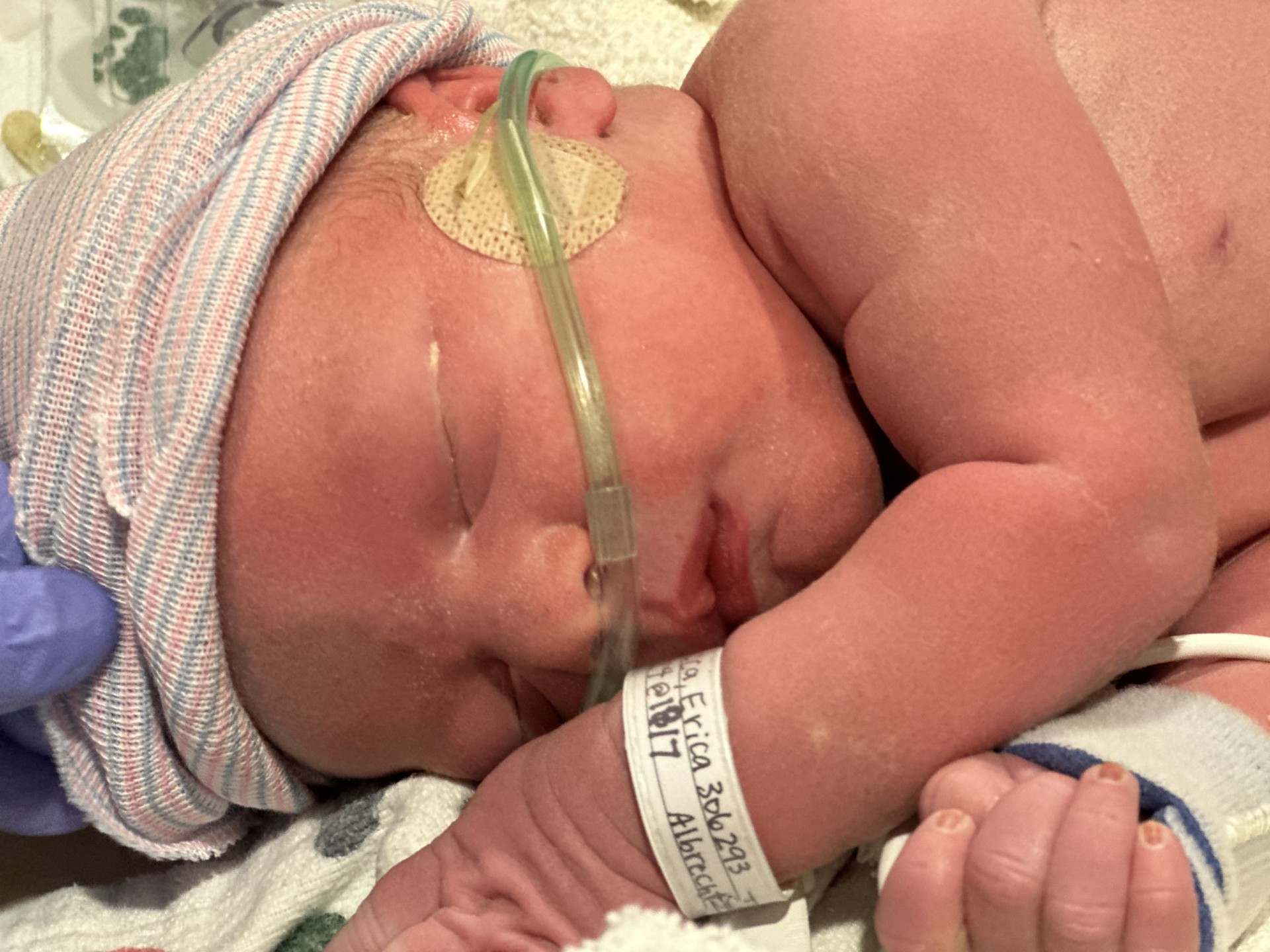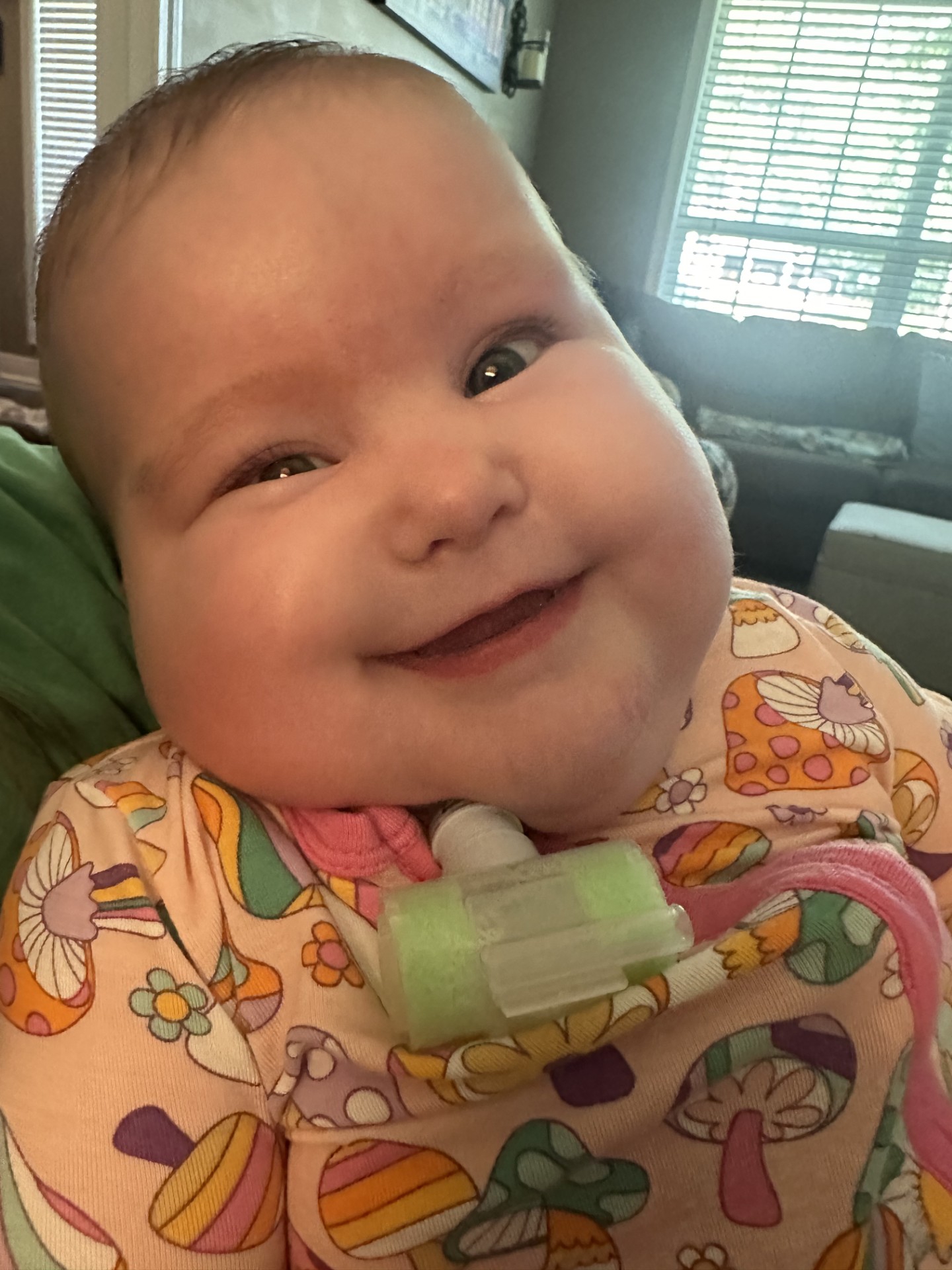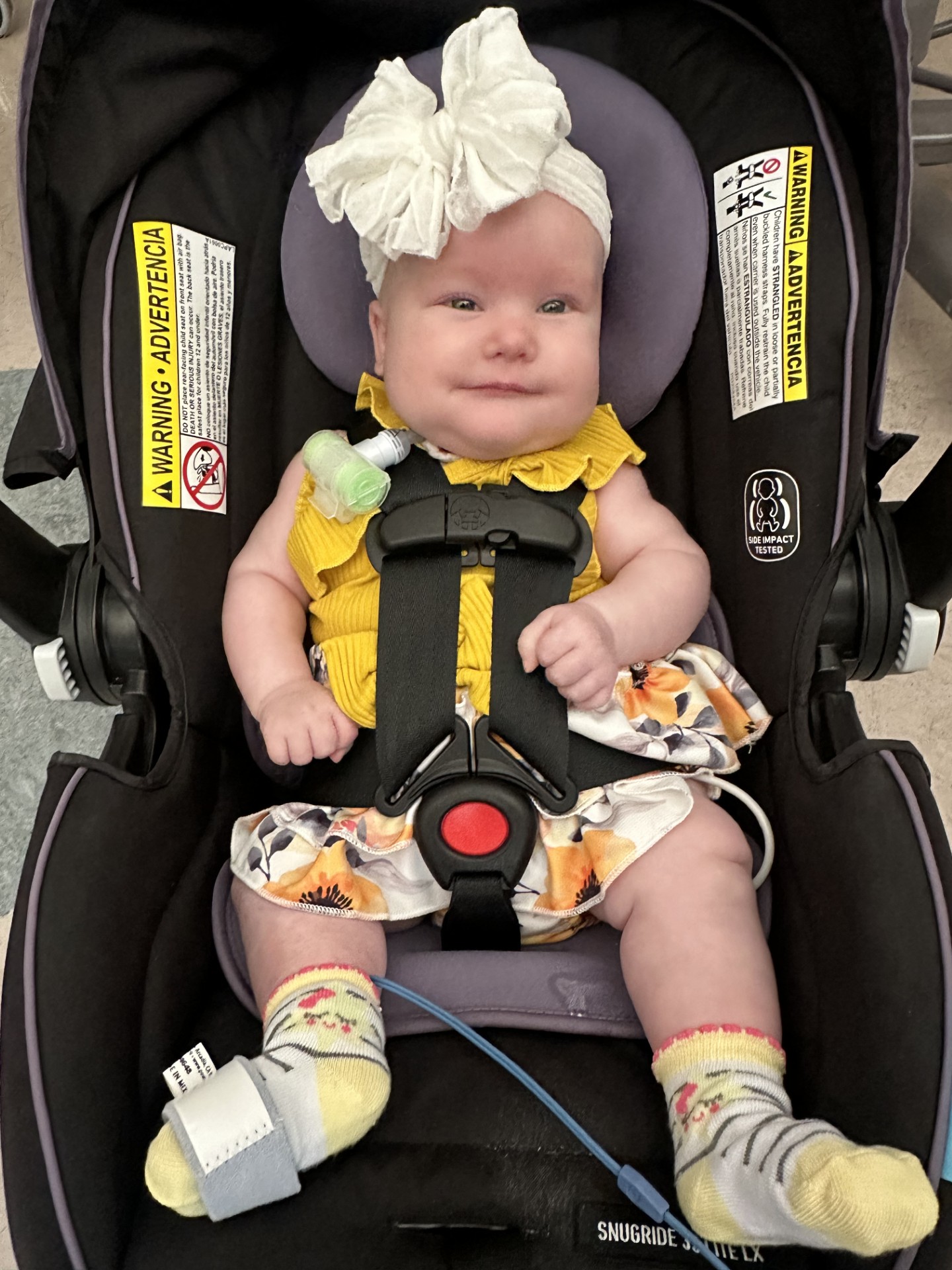Zoey's remarkable journey through a severe form of spina bifida
- Category: Patient Stories
- Posted on:
.jpg)
In July 2023, after experiencing a miscarriage just months earlier, Erica Racca and her husband, Elliott, were thrilled, but cautious when they discovered they were expecting again.
Erica remembers the moment vividly: “I took a home pregnancy test, and at first, I couldn’t see a line—it was very faint. I put it up to the light and could barely make it out. When I took another test the next day, it was clearer. We were cautiously optimistic, and at the same time, we were extremely excited.”
Despite their initial anxiety, the pregnancy seemed to progress smoothly. Erica was prescribed progesterone supplements to support her pregnancy due to low progesterone levels that likely had contributed to the previous miscarriage. She took them for 10 weeks until her levels were normal.
As the months progressed, everything seemed fine, but as the pregnancy advanced, Erica faced several challenges. At 35-weeks, she developed hypertension, and by 36-weeks, her OB-GYN in Alexandria, Louisiana, discussed the possibility of inducing labor due to her extremely high blood pressure.
Zoey was born at Cabrini Hospital in Alexandria on March 10, 2024, at 37-weeks following an induction. As Erica reached 10 centimeters and began pushing, her mind was more focused on her own hypertension than on the possibility of anything being wrong with her daughter. 
As Zoey entered the world, the atmosphere in the delivery room shifted. Initially, she was placed on Erica's chest, but something was off—Zoey wasn’t crying as expected. The nurses took her to be examined. It was then that they discovered a small opening on Zoey’s back. Zoey had been born with myelomeningocele, a form of spina bifida.
“She didn’t have a sac protruding from her back—just an opening,” recalled Erica.
__________________________________________________________________________
Myelomeningocele: A form of spina bifida
A myelomeningocele is a severe form of spina bifida, a birth defect in which the spine and spinal cord don’t form properly. In a myelomeningocele, a sac containing part of the spinal cord, its membranes, and fluid protrudes through an opening in the baby’s back. This condition can lead to significant neurological impairment, including problems with mobility, bladder and bowel control, and other physical and cognitive issues.
How is it diagnosed?
A myelomeningocele can sometimes be detected during pregnancy through:
Prenatal ultrasound: Abnormalities in the spine or brain may be seen on an ultrasound, usually around 18-20 weeks of gestation.
Maternal blood tests: Elevated levels of alpha-fetoprotein (AFP) in the mother's blood may indicate a neural tube defect like myelomeningocele.
Amniocentesis: This test can confirm the diagnosis by detecting increased levels of AFP and acetylcholinesterase in the amniotic fluid.
How is it treated?
Treatment for a myelomeningocele typically involves surgery, either before or after birth:
Postnatal surgery: Shortly after birth, surgeons will close the opening in the baby’s back to protect the spinal cord from further damage and reduce the risk of infection.
Fetal surgery: In some cases, surgery can be performed before birth to repair the defect, potentially reducing the risk of complications and improving outcomes.
What does follow-up care look like?
Children with a myelomeningocele often require ongoing medical care and therapies to address mobility challenges, bladder and bowel function, and other health issues. A multidisciplinary team including neurosurgeons, orthopedic surgeons, urologists, and physical therapists typically manages their care.
________________________________________________________________
The diagnosis was a shock to everyone. Despite multiple ultrasounds, spina bifida had not been detected during the pregnancy.
"When they told us Zoey had spina bifida, we were shocked,” said Erica. “We did everything right—the ultrasounds, the check-ups—there was no indication anything was wrong. But when I saw that little hole in her back, my heart just sank. I couldn’t believe it. I felt like the world stopped in that moment."
Within 30 minutes of her birth, Zoey was transferred to the neonatal intensive care unit (NICU) for closer observation. Shortly after, she was airlifted to Children’s Hospital New Orleans, where her parents would soon follow, overwhelmed with concern and uncertainty.
At the Neonatal Intensive Care Unit (NICU) at Children’s Hospital New Orleans, Zoey was immediately placed under the care of a comprehensive team of pediatric doctors- Maradith Skalak, MD, a neonatologist, Oritsejolomi Roberts, MD, a pediatric neurosurgeon, and Mohamad Masoumy, MD, surgical director for Plastics and Craniofacial Surgery. 
Dr. Roberts from the Pediatric Neurosurgery Program at Children’s Hospital New Orleans explained the procedure to repair Zoey's spina bifida, and discussed its severity with the Raccas. While Zoey had good mobility and movement, he cautioned she might face challenges with stability and sensation from the knees down. Additionally, Dr. Roberts expressed concerns about potential new neurological or bowel/bladder problems, which could arise with surgery or as her condition progressed. The outcome was uncertain, and only time would reveal the full extent of her condition.
Two days after her birth on March 12, 2024, Zoey underwent surgery to close the opening in her spine.
Dr. Roberts, the neurosurgeon, and Dr. Masoumy, the plastic surgeon, worked together to repair Zoey’s spina bifida. Dr. Roberts focused on closing the defect in Zoey's spine by bringing the edges of the opening together to protect the spinal cord and nerves. Dr. Masoumy then ensured the muscles and surrounding connective tissue were properly closed without tension before covering the area with skin and tissue to promote healing and reduce infection risk.
The surgery was successful, but the road to recovery was long. Zoey spent the next three-and-a-half months in the hospital. Her parents watched as she bravely fought through the challenges, including meticulous care of her back closure which required a wound vac to protect and aid in healing. They also faced the emotional toll of watching their baby endure so much at such a young age.
"Watching Zoey endure so many procedures and recoveries was heart-wrenching,” said Erica. “Every day felt like an emotional rollercoaster. We felt helpless at times, but seeing her fight so hard gave us strength. It was tough, but we focused on each small victory and the hope that things would get better."
Zoey faced other challenges during her recovery. She developed hydrocephalus, a condition where fluid builds up in the brain. Nearly two weeks after her initial surgery, Dr. Roberts performed another procedure to place a shunt to relieve the pressure on Zoey’s brain. She also developed respiratory issues which required a tracheostomy. This was another hurdle for Zoey, but once again, she was resilient. Zoey was finally discharged on June 27, 2024, after nearly four months in the hospital.
Today, at 7 months old, she’s making remarkable progress. Zoey has a G-tube for feeding, and she also has a tracheostomy due to vocal cord paralysis, which likely contributed to her quietness at birth. 
Despite these challenges, she’s hitting her milestones—holding her head up, moving her legs, and showing great mobility. Dr. Roberts continues to follow Zoey’s progress every six months, and Zoey has physical, speech, and occupational therapy twice a week at a clinic closer to home.
While the future is uncertain, Zoey’s prognosis is promising. Her parents hold onto hope that she will walk one day, but they know it’s a matter of time. Zoey’s remarkable progress has been an inspiration, not only to her family but also to the medical team that has supported her every step of the way.
“Everybody has been wonderful,” said Erica. “For other families facing similar struggles, my best piece of advice is to trust the process. Trust the doctors and nurses. Ask questions. That’s going to give you peace of mind and to keep the faith. Focus on the positive, not the negative. We were blessed to have a wonderful care team at Children’s Hospital who helped us in this journey and made it more bearable.”
For more information about the neonatal intensive care team at Children’s Hospital New Orleans visit Neonatal Intensive Care | Children's Hospital New Orleans (chnola.org).
To learn more about the pediatric neurosurgery program, visit Neurosurgery | Children's Hospital New Orleans (chnola.org)
To learn more about our plastic reconstructive surgical program, visit https://www.chnola.org/services/plastic-reconstructive-surgery/



